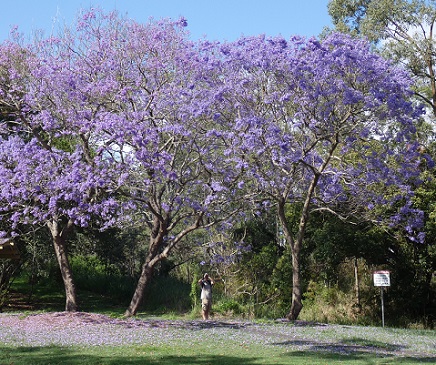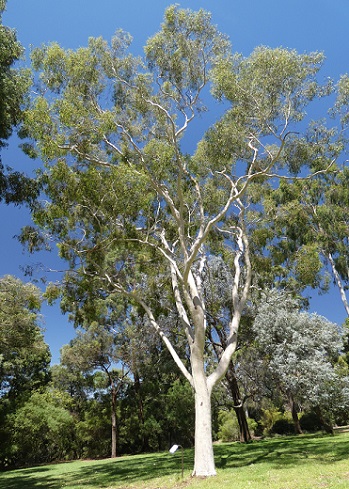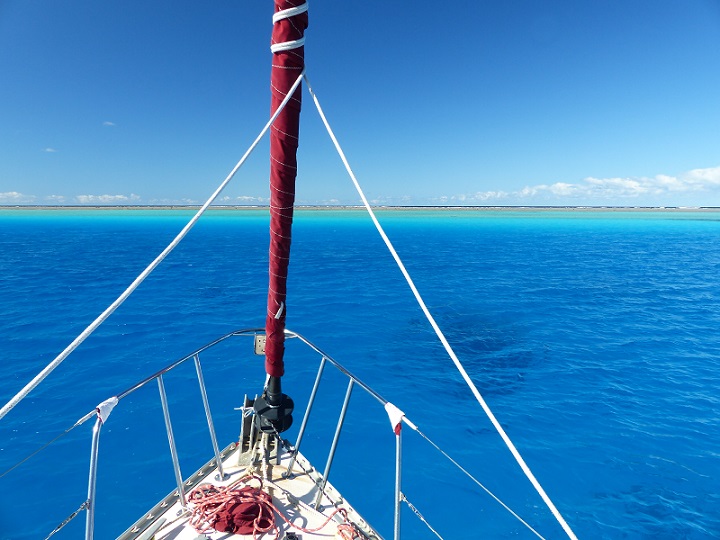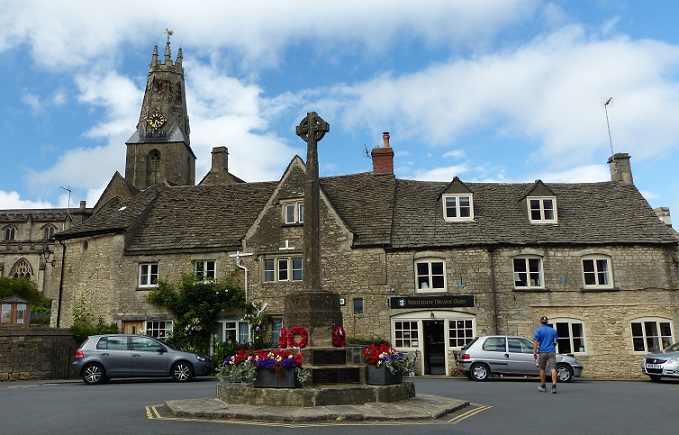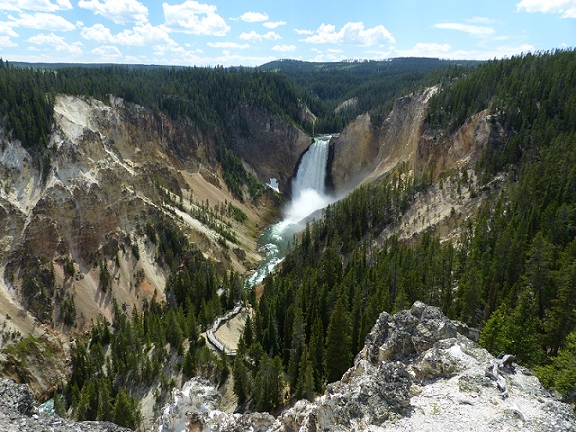
Tregoning
12 April 2024 | We are back aboard Tregoning in Mersin Marina, Mersin, Türkiye
02 April 2024 | We are in Toronto Airport, Canada: Tregoning is in Mersin Marina, Mersin, Türkiye
25 February 2024 | We are back in Gainesville, FL: Tregoning is in Mersin Marina, Mersin, Türkiye
18 February 2024 | We are in Glenwood, New Mexico: Tregoning is in Mersin Marina, Mersin, Türkiye
12 February 2024 | We are in Morro Bay, California: Tregoning is in Mersin Marina, Mersin, Türkiye
19 January 2024 | We are in Vancouver, BC Canada: Tregoning is in Mersin Marina, Mersin, Türkiye
01 January 2024 | We are in Washington State: Tregoning is in Mersin Marina, Mersin, Türkiye
15 December 2023 | We are in Minnesota: Tregoning is in Mersin Marina, Mersin, Türkiye
18 November 2023 | We are in Florida: Tregoning is in Mersin Marina, Mersin, Türkiye
29 October 2023 | We're in Florida - Tregoning is at B-dock, Mersin Marina, Mersin, Türkiye
21 October 2023 | 7 Oda Kapadokya Cave Hotel, Ürgüp, Türkiye
14 October 2023 | Hotel Aşikoğlu, Boğazkale, Türkiye
07 October 2023 | B-dock, Mersin Marina, Mersin, Türkiye
19 September 2023 | “Chez Jon & Angela”, Near Otterton, Devon, UK
14 September 2023 | Airbnb in Fortuneswell on the Isle of Portland, Dorset, UK
11 September 2023 | With Mike, Grange-over-Sands, Cumbria, UK
03 September 2023 | Ardington House, Ardington, Oxfordshire, UK
24 August 2023 | Near "Chez Joan and Peter", College of Roseisle, Moray, Scotland
11 August 2023 | Andrew's house (not exactly), Lichfield, UK
22 July 2023 | Chez Gail, near the New York Café, Budapest, Hungary
The Palace of Westminster
25 July 2016 | Tregoning is in Whangarei Town Basin Marina, Whangarei, New Zealand but we are in Godalming, Surrey, Great Britain
Photo: The Elizabeth Tower (home to Big Ben and formerly Westminster Tower) and the London Eye, seen from the roof of the Houses of Parliament, London, Great Britain

Our six-week trip to Great Britain was planned as a chance to see as many friends and relations as possible throughout the country but that did not mean that we were going to ignore opportunities to do some sightseeing. And within 48 hours of our arrival (on July 21st), we found ourselves on a private tour inside Westminster Palace, marveling at the beautiful and history-loaded buildings of the Houses of Parliament of the United Kingdom. Our back-stage tour was courtesy of nephew Roger and his flat-mate Katherine, who works in an office on the Commons side of the magnificent complex, and to them both we are very grateful.
On the north bank of the River Thames, in the City of Westminster in central London, the iconic buildings have been a UNESCO World Heritage Site since 1987 and are owned by the monarch. The first royal palace was built by Canute the Great on the site around 1016, but the oldest surviving part of the Palace (Westminster Hall) dates from 1097, during the reign of King William II. Westminster was the primary residence of the Kings of England until fire destroyed much of the complex in 1512. After that, it served as the home of the Parliament of England, which had been meeting there since the 13th century, and also as the seat of the Royal Courts of Justice. For ceremonial purposes, Westminster Palace retains its original status as a royal residence.
In 1834, an even greater fire ravaged the heavily rebuilt Houses of Parliament, and the only significant medieval structures to survive were Westminster Hall, the Cloisters of St Stephen's, the Chapel of St Mary Undercroft, and the Jewel Tower. From 1830 to 1870 the New Palace was rebuilt in the Gothic Revival style of the 14th to 16th centuries, with the remains of the Old Palace (other than the detached Jewel Tower) incorporated into the much larger, new building which has more than 1,110 rooms organized symmetrically around two courtyards.
The Palace of Westminster was hit by bombs on 14 occasions during the Blitz of World War II. During the worst raid in May 1941, the chamber of the House of Commons and the roof of Westminster Hall were set on fire. The latter was saved but the Commons Chamber was destroyed. For the rest of the war, the Commons met in the Lords Chamber and the Lords met in the Queens Robing Room but by 1950 the Commons Chamber had been rebuilt in a simplified version of the old chamber’s style.
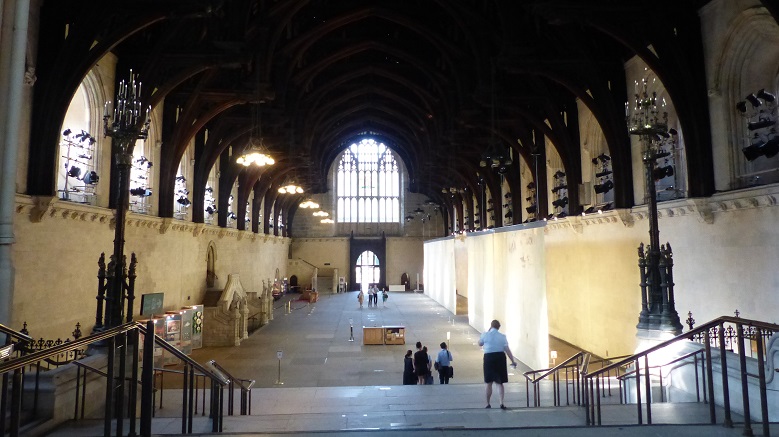
Westminster Hall
Our tour started in the ancient Westminster Hall, which at the time of its construction was the largest hall in Europe. The original roof was probably supported by pillars, giving three aisles, but in 1393, during the reign of King Richard II, this was replaced by a hammer-beam roof. This created a single huge open space, with a dais at the end, and is the largest clear-span medieval roof in England, measuring 68 by 240 feet (21 by 73 m). Although simply adorned, the massive Hall is an absolutely magnificent witness to so many important people and events of British history.
Primarily used for judicial purposes, Westminster Hall housed three of the most important courts in the land: the Court of King's Bench, the Court of Common Pleas, and the Court of Chancery before these courts were moved and amalgamated into the High Court of Justice in the late 1800s. Certain high-profile trials were conducted in Westminster Hall (such as that of Guy Fawkes who led a failed, Roman Catholic plot to blow up Westminster Palace, King James I, his family, and much of the Protestant government and aristocracy during the State Opening of Parliament on November 5th, 1605). The Hall has also served many ceremonial functions, such as coronation banquets, Addresses to the Crown on important public occasions (such as the Diamond Jubilee of Queen Elizabeth II in 2012), addresses by foreign leaders to both houses of parliament (such as Barack Obama in 2011), and the Laying in State of British monarchs, their consorts, and a few important public figures (such as Sir Winston Churchill in 1965).
We then descended to the Chapel of St Mary Undercroft which was another of the few structures to survive the fire of 1834. It had been a rarely used crypt below St Stephen's Chapel until the latter was destroyed in 1834, at which time the Undercroft was returned to its former use as a place of worship. Katherine told us that she had sung in a choir in this Chapel which is where members of parliament and peers may have christenings and where certain children of peers may be married.
We walked through many hallways and chambers, with Katherine telling us about their current use and Roger adding the historical perspective, such as noting the spot in the lobby of the House of Commons where Spencer Perceval fell, the only British Prime Minister to have been assassinated. Many walls were covered with huge frescos depicting important events in British history or with portraits of monarchs or other important public figures. To remind you which side of the building you are in, the furnishings are colored red in the House of Lords and green in the House of Commons.
Originally named "Octagon Hall" because of its shape, the Central Lobby is the heart of the Palace of Westminster. It forms a busy crossroads between the House of Lords to the south and the House of Commons to the north. Constituents may meet their Members of Parliament here, even without an appointment, and this practice is one of the possible origins of the term “lobbying”.
On our way to the Chamber of the House of Lords, we visited the richly decorated Queen's Robing Room. Predictably, this is where the Sovereign prepares for the State Opening of Parliament by donning official robes and, while sitting on the elaborate Chair of State, the Imperial State Crown is placed on their head.
Immediately north of the Robing Room is the Royal Gallery which is one of the largest rooms in the Palace and through which the royal procession passes on the way to the State Openings of Parliament. In addition to two huge frescos, depicting the death of Lord Nelson at the Battle of Trafalgar in 1805 and the Duke of Wellington at the Battle of Waterloo in 1815, the walls support large portraits of the kings and queens since George I (died 1727).
The lavishly decorated Chamber of the House of Lords is surprising small at 45 by 80 feet (14 by 24 m). The benches which the members of the House occupy are upholstered in red and surround three sides of the Chamber. At the southern end are the ornate gold Canopy and Throne where the Sovereign sits during the State Opening of Parliament. In front of the Throne is the Woolsack, an armless red cushion stuffed with wool (representing the historical importance of the wool trade) which is used by the officer presiding over the House, formerly the Lord Chancellor but since 2006 the Lord Speaker. With the throne, beautiful furnishings, and detailed stained glass windows and frescos at the upper level of the chamber, it is slightly incongruous to see a forest of small microphones suspended from the ceiling but this is a good reminder that despite all of the ceremony and tradition surrounding events such as the State Opening of Parliament, this is a working room, the debating chamber of a part of the nation’s government.
The Parliament had finished that day for the summer recess so there were very few people in the buildings but because of another tour group, we were not permitted to visit the Chamber of the House of Commons at the north end of the Palace of Westminster. Measuring only 46 by 68 feet (14 by 21 m), this Chamber can only accommodate 427 of the 650 Members of Parliament. During Prime Minister's Questions and in major debates, some MPs have to stand at either end of the Chamber. Rebuilt shortly after World War II, this Chamber is much more austere than the Lords’ Chamber although it does have the green furnishings associated with the House of Commons. The Speaker’s Chair is at the north end of the Chamber and members of the Government’s party occupy the benches to the Speaker’s right, with members of the Opposition to the left. By tradition, the British Sovereign does not enter the Chamber of the House of Commons, just as MPs do not enter the Chamber of the House of Lords.
The last part of our tour was to walk on the roof over the north end of the Palace, from which we had a fabulous view of the three towers and down into the northern courtyard. The rooftop was almost half way up the northern, Elizabeth Tower (formerly Westminster Tower) and close enough to get a good earful of the bells chiming at 7:30 pm. Big Ben is the most famous and heaviest of the five bells but it only strikes the hours. With four dials that are 23 feet (7 m) in diameter, the Great Clock of Westminster has remained a reliable timekeeper since it entered service in 1859.
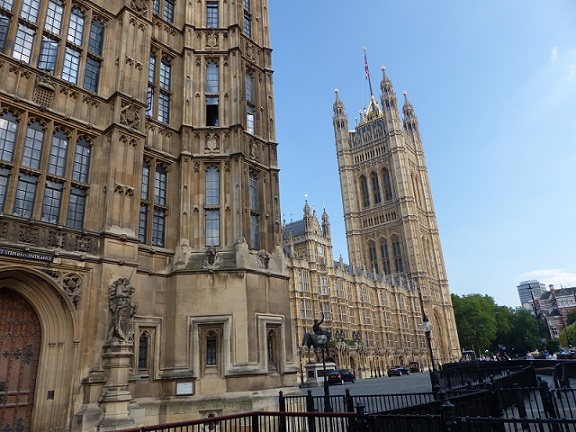
West side of the Houses of Parliament and the Victoria Tower
At the other end of the Palace, is the Victoria Tower which upon its completion in 1858, was the tallest secular building in the world. At height of 323 feet (98 m), the Victoria Tower is only a little taller than the Elizabeth Tower, but it is significantly broader. This tower houses a fireproof repository for the archives of Parliament, which contains three million documents including master copies of all Acts of Parliament since 1497, and important manuscripts such as the original Bill of Rights and the death warrant of King Charles I. Other towers include the octagonal Central Tower which stands immediately above the Central Lobby and the Speaker's Tower which contains Speaker's House, the official residence of the Speaker of the Commons.
We concluded our tour with a visit to a bar on the ground floor that is one of the many bars, cafeterias, and restaurants in the Palace of Westminster. This massive building is in need of major restoration work to fix much of the deterioration in the stonework and leaking roofs that have accumulated since the mid-1800s, to remove asbestos, modernize communication and fire-prevention systems, and to improve energy efficiency and disabled access. It has been estimated MPs and Peers might have to be moved to another location for six years and that alone might cost over £4 billion on top of the actual restoration costs which might be a similar figure. That exceptionally large amount of money is particularly controversial at the moment given the uncertainty created by the vote for Britain to leave the European Union (Brexit). However, it is a World UNESCO Heritage site and it is also difficult to contemplate the skyline of the River Thames without this iconic building.
Prior to meeting Roger and Katherine, we had spent a wonderful night in Harrow with the amazingly energetic Jennie and her three beautiful daughters. Knowing that we would see them again at the end of our trip made it tolerable to stop for only one night. The following day we had lunch with Aunt Tilly in Chalfont St Peter. I had not seen her in years and she had never met Randall so we had plenty of news to catch-up with. After our delightful evening in the Palace of Westminster, we stayed with Roger in West Hampstead and enjoyed a stroll on Hampstead Heath the next morning.
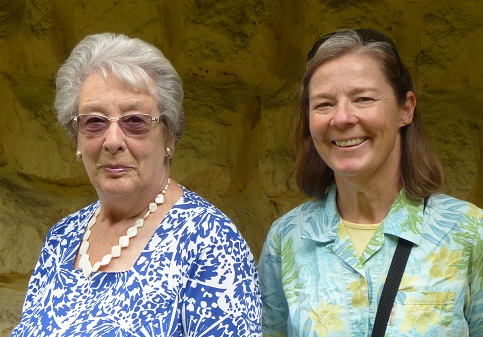
Tilly and Alison
This was before we met with two of my school friends, Mary and Clare, neither of whom I had seen in at least 25 years, and indulged ourselves in a four-and-a-half hour lunch. Luckily, Roger came along to order a wide variety of small Turkish dishes and to provide Randall with some company while we girls were reminiscing. Mary lives in Milan, Italy, so we were very lucky to catch her while she was in Britain visiting her parents.
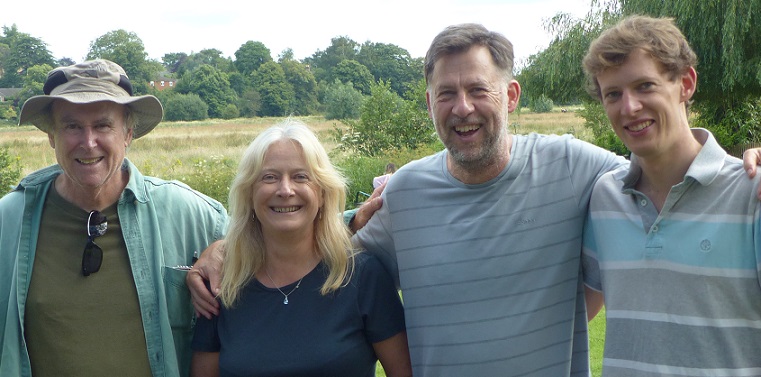
Randall, Clare, Andy, and Jonathan
After our marathon lunch date, we went home with Clare to their spacious house and garden in Godalming, Surrey. We spent a lovely couple of nights there getting very exciting because Clare had retired just the day before and in four short months, she and her husband Andy were going start full-time cruising. It was so fun to swap sailing stories (they have chartered boats in the Mediterranean and Caribbean for years) and to remind ourselves of the nervous anticipation of preparing for such a major change in lifestyle. It was also a wonderful opportunity for us to find that even though we were thoroughly enjoying seeing so many friends and relations, once we let our minds drift ocean-ward, we really, really were looking forward to our return to Tregoning.
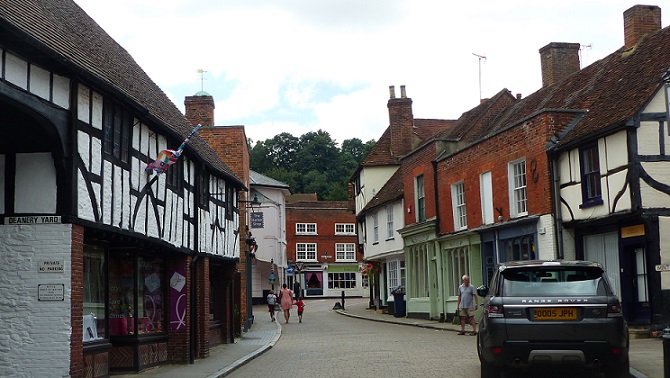
One of the quaint streets in Godalming
On the north bank of the River Thames, in the City of Westminster in central London, the iconic buildings have been a UNESCO World Heritage Site since 1987 and are owned by the monarch. The first royal palace was built by Canute the Great on the site around 1016, but the oldest surviving part of the Palace (Westminster Hall) dates from 1097, during the reign of King William II. Westminster was the primary residence of the Kings of England until fire destroyed much of the complex in 1512. After that, it served as the home of the Parliament of England, which had been meeting there since the 13th century, and also as the seat of the Royal Courts of Justice. For ceremonial purposes, Westminster Palace retains its original status as a royal residence.
In 1834, an even greater fire ravaged the heavily rebuilt Houses of Parliament, and the only significant medieval structures to survive were Westminster Hall, the Cloisters of St Stephen's, the Chapel of St Mary Undercroft, and the Jewel Tower. From 1830 to 1870 the New Palace was rebuilt in the Gothic Revival style of the 14th to 16th centuries, with the remains of the Old Palace (other than the detached Jewel Tower) incorporated into the much larger, new building which has more than 1,110 rooms organized symmetrically around two courtyards.
The Palace of Westminster was hit by bombs on 14 occasions during the Blitz of World War II. During the worst raid in May 1941, the chamber of the House of Commons and the roof of Westminster Hall were set on fire. The latter was saved but the Commons Chamber was destroyed. For the rest of the war, the Commons met in the Lords Chamber and the Lords met in the Queens Robing Room but by 1950 the Commons Chamber had been rebuilt in a simplified version of the old chamber’s style.

Westminster Hall
Our tour started in the ancient Westminster Hall, which at the time of its construction was the largest hall in Europe. The original roof was probably supported by pillars, giving three aisles, but in 1393, during the reign of King Richard II, this was replaced by a hammer-beam roof. This created a single huge open space, with a dais at the end, and is the largest clear-span medieval roof in England, measuring 68 by 240 feet (21 by 73 m). Although simply adorned, the massive Hall is an absolutely magnificent witness to so many important people and events of British history.
Primarily used for judicial purposes, Westminster Hall housed three of the most important courts in the land: the Court of King's Bench, the Court of Common Pleas, and the Court of Chancery before these courts were moved and amalgamated into the High Court of Justice in the late 1800s. Certain high-profile trials were conducted in Westminster Hall (such as that of Guy Fawkes who led a failed, Roman Catholic plot to blow up Westminster Palace, King James I, his family, and much of the Protestant government and aristocracy during the State Opening of Parliament on November 5th, 1605). The Hall has also served many ceremonial functions, such as coronation banquets, Addresses to the Crown on important public occasions (such as the Diamond Jubilee of Queen Elizabeth II in 2012), addresses by foreign leaders to both houses of parliament (such as Barack Obama in 2011), and the Laying in State of British monarchs, their consorts, and a few important public figures (such as Sir Winston Churchill in 1965).
We then descended to the Chapel of St Mary Undercroft which was another of the few structures to survive the fire of 1834. It had been a rarely used crypt below St Stephen's Chapel until the latter was destroyed in 1834, at which time the Undercroft was returned to its former use as a place of worship. Katherine told us that she had sung in a choir in this Chapel which is where members of parliament and peers may have christenings and where certain children of peers may be married.
We walked through many hallways and chambers, with Katherine telling us about their current use and Roger adding the historical perspective, such as noting the spot in the lobby of the House of Commons where Spencer Perceval fell, the only British Prime Minister to have been assassinated. Many walls were covered with huge frescos depicting important events in British history or with portraits of monarchs or other important public figures. To remind you which side of the building you are in, the furnishings are colored red in the House of Lords and green in the House of Commons.
Originally named "Octagon Hall" because of its shape, the Central Lobby is the heart of the Palace of Westminster. It forms a busy crossroads between the House of Lords to the south and the House of Commons to the north. Constituents may meet their Members of Parliament here, even without an appointment, and this practice is one of the possible origins of the term “lobbying”.
On our way to the Chamber of the House of Lords, we visited the richly decorated Queen's Robing Room. Predictably, this is where the Sovereign prepares for the State Opening of Parliament by donning official robes and, while sitting on the elaborate Chair of State, the Imperial State Crown is placed on their head.
Immediately north of the Robing Room is the Royal Gallery which is one of the largest rooms in the Palace and through which the royal procession passes on the way to the State Openings of Parliament. In addition to two huge frescos, depicting the death of Lord Nelson at the Battle of Trafalgar in 1805 and the Duke of Wellington at the Battle of Waterloo in 1815, the walls support large portraits of the kings and queens since George I (died 1727).
The lavishly decorated Chamber of the House of Lords is surprising small at 45 by 80 feet (14 by 24 m). The benches which the members of the House occupy are upholstered in red and surround three sides of the Chamber. At the southern end are the ornate gold Canopy and Throne where the Sovereign sits during the State Opening of Parliament. In front of the Throne is the Woolsack, an armless red cushion stuffed with wool (representing the historical importance of the wool trade) which is used by the officer presiding over the House, formerly the Lord Chancellor but since 2006 the Lord Speaker. With the throne, beautiful furnishings, and detailed stained glass windows and frescos at the upper level of the chamber, it is slightly incongruous to see a forest of small microphones suspended from the ceiling but this is a good reminder that despite all of the ceremony and tradition surrounding events such as the State Opening of Parliament, this is a working room, the debating chamber of a part of the nation’s government.
The Parliament had finished that day for the summer recess so there were very few people in the buildings but because of another tour group, we were not permitted to visit the Chamber of the House of Commons at the north end of the Palace of Westminster. Measuring only 46 by 68 feet (14 by 21 m), this Chamber can only accommodate 427 of the 650 Members of Parliament. During Prime Minister's Questions and in major debates, some MPs have to stand at either end of the Chamber. Rebuilt shortly after World War II, this Chamber is much more austere than the Lords’ Chamber although it does have the green furnishings associated with the House of Commons. The Speaker’s Chair is at the north end of the Chamber and members of the Government’s party occupy the benches to the Speaker’s right, with members of the Opposition to the left. By tradition, the British Sovereign does not enter the Chamber of the House of Commons, just as MPs do not enter the Chamber of the House of Lords.
The last part of our tour was to walk on the roof over the north end of the Palace, from which we had a fabulous view of the three towers and down into the northern courtyard. The rooftop was almost half way up the northern, Elizabeth Tower (formerly Westminster Tower) and close enough to get a good earful of the bells chiming at 7:30 pm. Big Ben is the most famous and heaviest of the five bells but it only strikes the hours. With four dials that are 23 feet (7 m) in diameter, the Great Clock of Westminster has remained a reliable timekeeper since it entered service in 1859.

West side of the Houses of Parliament and the Victoria Tower
At the other end of the Palace, is the Victoria Tower which upon its completion in 1858, was the tallest secular building in the world. At height of 323 feet (98 m), the Victoria Tower is only a little taller than the Elizabeth Tower, but it is significantly broader. This tower houses a fireproof repository for the archives of Parliament, which contains three million documents including master copies of all Acts of Parliament since 1497, and important manuscripts such as the original Bill of Rights and the death warrant of King Charles I. Other towers include the octagonal Central Tower which stands immediately above the Central Lobby and the Speaker's Tower which contains Speaker's House, the official residence of the Speaker of the Commons.
We concluded our tour with a visit to a bar on the ground floor that is one of the many bars, cafeterias, and restaurants in the Palace of Westminster. This massive building is in need of major restoration work to fix much of the deterioration in the stonework and leaking roofs that have accumulated since the mid-1800s, to remove asbestos, modernize communication and fire-prevention systems, and to improve energy efficiency and disabled access. It has been estimated MPs and Peers might have to be moved to another location for six years and that alone might cost over £4 billion on top of the actual restoration costs which might be a similar figure. That exceptionally large amount of money is particularly controversial at the moment given the uncertainty created by the vote for Britain to leave the European Union (Brexit). However, it is a World UNESCO Heritage site and it is also difficult to contemplate the skyline of the River Thames without this iconic building.
Prior to meeting Roger and Katherine, we had spent a wonderful night in Harrow with the amazingly energetic Jennie and her three beautiful daughters. Knowing that we would see them again at the end of our trip made it tolerable to stop for only one night. The following day we had lunch with Aunt Tilly in Chalfont St Peter. I had not seen her in years and she had never met Randall so we had plenty of news to catch-up with. After our delightful evening in the Palace of Westminster, we stayed with Roger in West Hampstead and enjoyed a stroll on Hampstead Heath the next morning.

Tilly and Alison
This was before we met with two of my school friends, Mary and Clare, neither of whom I had seen in at least 25 years, and indulged ourselves in a four-and-a-half hour lunch. Luckily, Roger came along to order a wide variety of small Turkish dishes and to provide Randall with some company while we girls were reminiscing. Mary lives in Milan, Italy, so we were very lucky to catch her while she was in Britain visiting her parents.

Randall, Clare, Andy, and Jonathan
After our marathon lunch date, we went home with Clare to their spacious house and garden in Godalming, Surrey. We spent a lovely couple of nights there getting very exciting because Clare had retired just the day before and in four short months, she and her husband Andy were going start full-time cruising. It was so fun to swap sailing stories (they have chartered boats in the Mediterranean and Caribbean for years) and to remind ourselves of the nervous anticipation of preparing for such a major change in lifestyle. It was also a wonderful opportunity for us to find that even though we were thoroughly enjoying seeing so many friends and relations, once we let our minds drift ocean-ward, we really, really were looking forward to our return to Tregoning.

One of the quaint streets in Godalming
Comments
| Vessel Name: | Tregoning |
| Vessel Make/Model: | Morgan Classic 41 |
| Hailing Port: | Gainesville, FL |
| Crew: | Alison and Randall |
| About: | We cast-off from Fernandina Beach in north Florida on 1st June 2008 and we have been cruising on Tregoning ever since. Before buying Tregoning, both of us had been sailing on smaller boats for many years and had worked around boats and water throughout our careers. |
| Extra: | “Tregoning” (rhymes with “belonging”) and is a Cornish word (meaning “homestead of Cohnan” or “farm by the ash trees”) and was Alison's mother’s middle name. Cornwall is in southwest England and is where Alison grew-up. |
Tregoning's Photos - Main
 |
Extra photographs from our three-week campervan tour of the South Island from November 15th to December 5th 2015
217 Photos
Created 4 January 2016
|
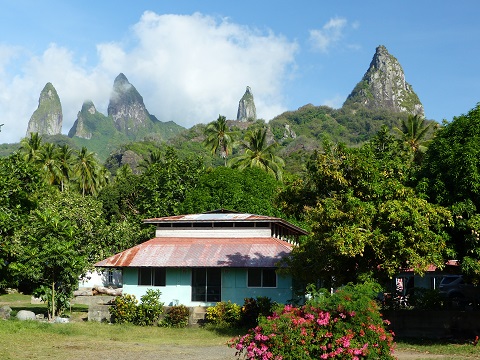 |
Random pictures from our month spent on the islands of Hiva Oa, Tahuata, Ua Pou, and Nuku Hiva
45 Photos
Created 18 July 2015
|
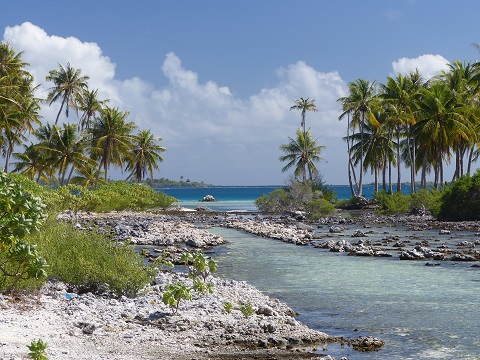 |
Random pictures from our month spent in 4 Tuamotu Atolls; Ahe, Fakarava, Tahanea, and Toau
32 Photos
Created 1 July 2015
|
 |
Some of the birds, fish, reptiles, and mammals (and others) that we have seen in Mexico
74 Photos
Created 5 May 2014
|
Tregoning

Who: Alison and Randall
Port: Gainesville, FL





